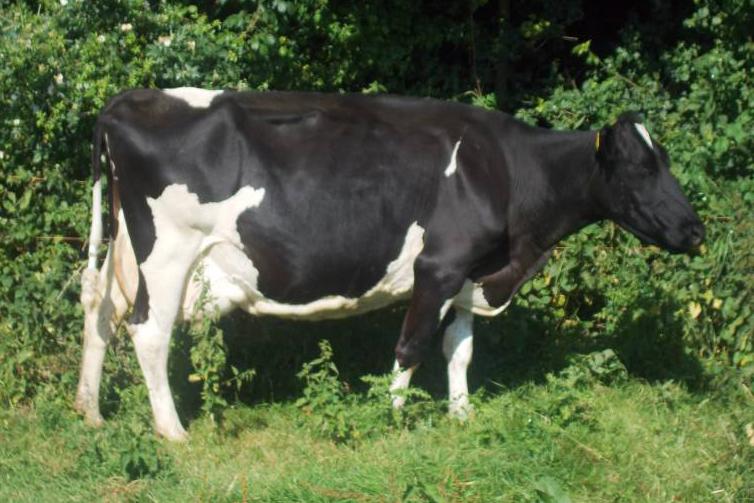When I stand in the yard and look round at my cows, I experience deep satisfaction and contemplate how my current herd came about.
It all goes back a long way. I was very lucky to meet and marry a girl who came from a town, but had a natural flair for breeding a good herd of cows. She also has something which I have discovered is a trait in many renowned breeders – a photographic memory of pedigrees. Potential buyers and classifiers are amazed that when presented with an animal she can recite the pedigree back to the year dot.
It all started back in 1910 when my grandfather established one of the first black and white herds in the country. When my wife took over the breeding herd many years ago, she was also working as a farm secretary for one of the top Holstein herds in the country, and didn’t like what she saw. Her response was to keep our Friesian herd for as long as possible.
Bulls with all-round characteristics
Then came the PIN system, which was heavily based on milk production alone. My wife thought that this just wasn’t right and continued to choose bulls for all-round characteristics, feet, udders, legs and always plus milk quality – not just high milk.
When a bull nicked into the herd, she would use it again, rather than going for the latest fashionable genetics. This approach helped to avoid interbreeding.
When good Friesian AI dried up, as the breed companies stopped proving Friesian bulls, she bred our own Friesian bull from a rare bloodline. This worked out extremely well - most of the offspring were classified VG and excellent and did at least seven lactations averaging 8,000 litres as mature cows.
We were so pleased with our own bull, that we started breeding our own 50% Friesian/50% Holstein bulls. Again, we were delighted with the results, and so were the organic farmers who bought bulls from us, although we are not organic ourselves.
Medium-sized cattle
My wife had always bred for medium-sized cattle as she didn’t want to buy more cubicles. This worked out very well in the long term, as farmers eventually realised that tall cattle weren’t all they were cracked up to be.
My wife’s latest project has been to breed a high butterfat bull with high fertility, using McCormick, the top butterfat and fertility bull, on our EX 92 star brood cow, who has always transmitted high milk quality to her daughters. The resulting offspring, Brinkworth Rhys, was our first homebred bull to be classified “excellent”. My wife has been watching the milk recordings of Brinkworth Rhys with bated breath, and we are both thrilled that the heifers are giving milk quality of over 5% butterfat, the top so far being 5.77%. Who needs crossbreeding?
Read more
Farmer writes: viewing a Brexit with trepidation
When I stand in the yard and look round at my cows, I experience deep satisfaction and contemplate how my current herd came about.
It all goes back a long way. I was very lucky to meet and marry a girl who came from a town, but had a natural flair for breeding a good herd of cows. She also has something which I have discovered is a trait in many renowned breeders – a photographic memory of pedigrees. Potential buyers and classifiers are amazed that when presented with an animal she can recite the pedigree back to the year dot.
It all started back in 1910 when my grandfather established one of the first black and white herds in the country. When my wife took over the breeding herd many years ago, she was also working as a farm secretary for one of the top Holstein herds in the country, and didn’t like what she saw. Her response was to keep our Friesian herd for as long as possible.
Bulls with all-round characteristics
Then came the PIN system, which was heavily based on milk production alone. My wife thought that this just wasn’t right and continued to choose bulls for all-round characteristics, feet, udders, legs and always plus milk quality – not just high milk.
When a bull nicked into the herd, she would use it again, rather than going for the latest fashionable genetics. This approach helped to avoid interbreeding.
When good Friesian AI dried up, as the breed companies stopped proving Friesian bulls, she bred our own Friesian bull from a rare bloodline. This worked out extremely well - most of the offspring were classified VG and excellent and did at least seven lactations averaging 8,000 litres as mature cows.
We were so pleased with our own bull, that we started breeding our own 50% Friesian/50% Holstein bulls. Again, we were delighted with the results, and so were the organic farmers who bought bulls from us, although we are not organic ourselves.
Medium-sized cattle
My wife had always bred for medium-sized cattle as she didn’t want to buy more cubicles. This worked out very well in the long term, as farmers eventually realised that tall cattle weren’t all they were cracked up to be.
My wife’s latest project has been to breed a high butterfat bull with high fertility, using McCormick, the top butterfat and fertility bull, on our EX 92 star brood cow, who has always transmitted high milk quality to her daughters. The resulting offspring, Brinkworth Rhys, was our first homebred bull to be classified “excellent”. My wife has been watching the milk recordings of Brinkworth Rhys with bated breath, and we are both thrilled that the heifers are giving milk quality of over 5% butterfat, the top so far being 5.77%. Who needs crossbreeding?
Read more
Farmer writes: viewing a Brexit with trepidation






 This is a subscriber-only article
This is a subscriber-only article











SHARING OPTIONS: